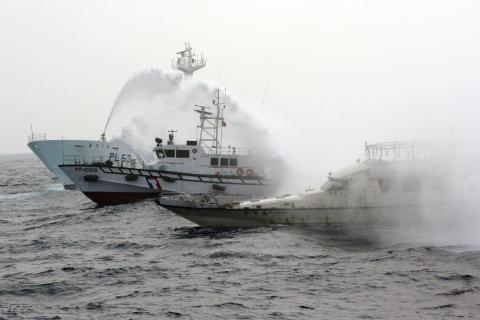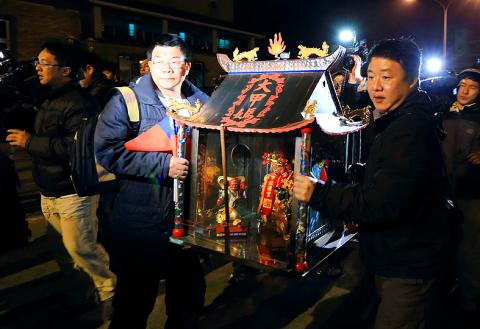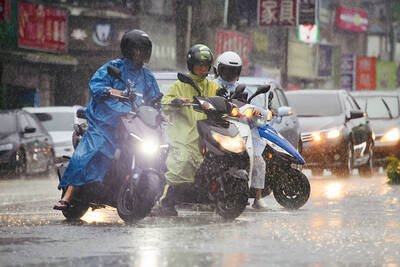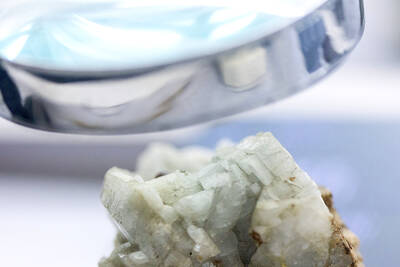The Ministry of Foreign Affairs (MOFA) yesterday urged Japan to adopt a “rational” attitude about a Taiwanese protest boat that sailed into waters near the disputed Diaoyutai Islands (釣魚台) earlier in the day.
“The voyage was a voluntary action by private citizens and should in no way affect Taiwan-Japan fishery talks,” said Su Chii-cherng (蘇啟誠), the deputy director-general of the ministry’s Department of East Asian and Pacific Affairs.
The boat, a fishing vessel chartered from Shenao Port (深澳漁港) in New Taipei City (新北市) and carrying seven crew and activists, set out early yesterday morning for the Diaoyutais, known as the Senkakus in Japan.

Photo: Taiwanese Coast Guard Administration / Reuters
The Diaoyutais lie in the East China Sea, about 120 nautical miles (220km) northeast of Taiwan, and are contested by Taiwan, Japan and China.
The activists are members of the Taipei-based Chinese Association for Protecting the Diaoyutais and said they had intended to enshrine a statute of Matsu, the Chinese goddess of the sea, on the uninhabited chain to protect Taiwanese seafarers and fishermen operating in the region and assert Taiwan’s sovereignty over the islands.
Despite being escorted by four Taiwanese Coast Guard Administration (CGA) vessels, the activists’ attempt to reach the islands was unsuccessful, although they managed to get as close as 16 nautical miles southwest of the islands.

Photo: CNA
Eight Japanese Coast Guard vessels blocked the Taiwanese boat’s progress when it reached 28 nautical miles southwest of the Diaoyutais at 9:40am, using tactics such as zig-zagging, creating wash and discharging black smoke, CGA officials said.
At 10:32am, the Japanese coast guard ships began firing water cannons at the fishing boat, they said. The CGA reacted by returning water cannon fire at the Japanese ships.
In addition, loudspeakers and LED display boards were used to send warning messages telling the Japanese to stop blocking the Taiwanese boat because “the Diaoyutai Islands are part of ROC [Republic of China] territory,” the officials said.
Also during the escort operation, Taiwan warned three Chinese marine surveillance ships that were spotted 20 nautical miles southwest of the Diaoyutais to leave the area, the officials said.
The action was aimed at avoiding the possibility of creating the false impression that Taipei was collaborating with Beijing over the territorial spat, the officials said.
Su yesterday said that Tokyo has expressed its concerns to the ministry over the incident.
“We have in turn reaffirmed our stance on the issue,” Su said.
Insisting that the Diaoyutais are an inherent part of the ROC’s territory, Su said that the waters surrounding the island chain are traditional Taiwanese fishing grounds.
“Our sovereignty over the Diaoyutais and their surrounding waters is indisputable,” Su said.
Su added that all those aboard the ship possessed the proper licenses and had applied to make the voyage in accordance with regulations.
“Our people are allowed to conduct fishing operations in the region,” Su said, adding that the CGA’s deployment of four escort ships was mainly to protect the safety of ROC citizens.
He urged Japan to adopt a “rational and peaceful” attitude in handling the incident.
Asked whether the dispute would hurt planned bilateral fisheries talks, Su said the Japanese had hinted at such a possibility.
“Both sides have been in talks to determine a timeline for a second preparatory meeting ahead of a new round of fishery talks,” Su said, adding that the government does not want the protest to affect negotiations.
“We look forward to the second preparatory meeting being held either late this month or in mid-February as originally scheduled,” Su added.
Taipei and Tokyo have already held 16 rounds of talks on fishing rights in the Diaoyutai waters. A preparatory meeting was held last year to pave the way for a long-stalled 17th round of talks.
The long-simmering row over the island chain came to a head in September last year after the Japanese government bought three of the islets from their private owner.
Chinese patrol ships, utility aircraft and jet fighters have since been spotted around the disputed island cluster on several occasions.
In August last year, President Ma Ying-jeou (馬英九) unveiled an East China Sea peace initiative based on the concept of “sovereignty cannot be shared yet resources can be divided.”
The initiative calls for all parties to refrain from provocation, shelve their differences, maintain dialogue, observe international law and resolve disputes through peaceful means.
Ma also called for all sides to seek consensus on a code of conduct for the East China Sea and to establish a mechanism to explore and develop resources in the region.

The combined effect of the monsoon, the outer rim of Typhoon Fengshen and a low-pressure system is expected to bring significant rainfall this week to various parts of the nation, the Central Weather Administration (CWA) said. The heaviest rain is expected to occur today and tomorrow, with torrential rain expected in Keelung’s north coast, Yilan and the mountainous regions of Taipei and New Taipei City, the CWA said. Rivers could rise rapidly, and residents should stay away from riverbanks and avoid going to the mountains or engaging in water activities, it said. Scattered showers are expected today in central and

COOPERATION: Taiwan is aligning closely with US strategic objectives on various matters, including China’s rare earths restrictions, the Ministry of Foreign Affairs said Taiwan could deal with China’s tightened export controls on rare earth metals by turning to “urban mining,” a researcher said yesterday. Rare earth metals, which are used in semiconductors and other electronic components, could be recovered from industrial or electronic waste to reduce reliance on imports, National Cheng Kung University Department of Resources Engineering professor Lee Cheng-han (李政翰) said. Despite their name, rare earth elements are not actually rare — their abundance in the Earth’s crust is relatively high, but they are dispersed, making extraction and refining energy-intensive and environmentally damaging, he said, adding that many countries have opted to

SUPPLY CHAIN: Taiwan’s advantages in the drone industry include rapid production capacity that is independent of Chinese-made parts, the economic ministry said The Executive Yuan yesterday approved plans to invest NT$44.2 billion (US$1.44 billion) into domestic production of uncrewed aerial vehicles over the next six years, bringing Taiwan’s output value to more than NT$40 billion by 2030 and making the nation Asia’s democratic hub for the drone supply chain. The proposed budget has NT$33.8 billion in new allocations and NT$10.43 billion in existing funds, the Ministry of Economic Affairs said. Under the new development program, the public sector would purchase nearly 100,000 drones, of which 50,898 would be for civil and government use, while 48,750 would be for national defense, it said. The Ministry of

African swine fever was confirmed at a pig farm in Taichung, the Ministry of Agriculture said today, prompting a five-day nationwide ban on transporting and slaughtering pigs, and marking the loss of Taiwan’s status as the only Asian nation free of all three major swine diseases. The ministry held a news conference today confirming that the virus was detected at a farm in Wuci District (梧棲) yesterday evening. Authorities preemptively culled 195 pigs at the farm at about 3am and disinfected the entire site to prevent the disease from spreading, the ministry said. Authorities also set up a 3km-radius control zone